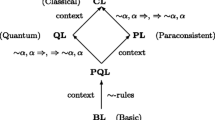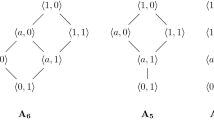Abstract
Lattice logic, bilattice logic, and paraconsistent quantum logic are investigated based on monosequent systems. Paraconsistent quantum logic is an extension of lattice logic, and bilattice logic is an extension of paraconsistent quantum logic. Monosequent system is a sequent calculus based on the restricted sequent that contains exactly one formula in both the antecedent and succedent. It is known that a completeness theorem with respect to a lattice-valued semantics holds for a monosequent system for lattice logic. A completeness theorem with respect to a lattice-valued semantics is proved for paraconsistent quantum logic, and a completeness theorem with respect to a bilattice-valued semantics is proved for bilattice logic. Some syntactical properties, including cut-elimination and duality, are also investigated for the monosequent systems for these logics.
Similar content being viewed by others
References
Almukdad, A., & Nelson, D. (1984). Constructible falsity and inexact predicates. Journal of Symbolic Logic, 49(1), 231–233.
Aoyama, H. (2003). On a weak system of sequent calculus. Journal of Logical Philosophy, 3, 29–37.
Aoyama, H. (2009). Dual-intuitionistic logic and some other logics. Journal of Logical Philosophy, 6, 34–56.
Arieli, O., & Avron, A. (1996). Reasoning with logical bilattices. Journal of Logic, Language and Information, 5, 25–63.
Arieli, O., & Avron, A. (1998). The value of the four values. Artificial Intelligence, 102(1), 97–141.
Belnap, N. (1977). A useful four-valued logic. In Epstein, G., & Dunn, J.M. (Eds.) Modern uses of multiple-valued logic (pp. 5–37). Dordrecht: Reidel.
Belnap, N. (1977). How a computer should think. In Ryle, G. (Ed.) Contemporary aspects of philosophy (pp. 30–56). Stocksfield: Oriel Press.
Béziau, J.-Y. (2017). Monosequent proof systems. In Caleiro, C., Dionisio, F., Gouveia, P., Mateus, P., & Rasga, J. (Eds.) Logic and computation – essays in honor of Amilcar Sernadas (pp. 111–137). London: College Publication.
Birkhoff, G., & von Neumann, J. (1936). The logic of quantum mechanics. Annals of Mathematics, 37, 823–843.
Cockett, J.R.B., & Seely, R.A.G. (2001). Finite sum-product logic. Theory and Applications of Categories, 8(5), 63–99.
Dalla Chiara, M.L., & Giuntini, R. (1989). Paraconsistent quantum logics. Foundations of Physics, 19(7), 891–904.
Dunn, J.M. (1976). Intuitive semantics for first-degree entailment and ‘coupled trees’. Philosophical Studies, 29, 149–168.
Dunn, J.M. (2000). Partiality and its dual. Studia Logica, 65, 5–40.
Dunn, J.M., & Hardegree, G.M. (2001). Algebraic methods in philosophical logic. Oxford, New York: Clarendon Press, Oxford University Press.
Faggian, C., & Sambin, G. (1998). From basic logic to quantum logics with cut-elimination. International Journal of Theoretical Physics, 37(1), 31–37.
Fitting, M. (1991). Bilattices and the semantics of logic programming. Journal of Logic Programming, 11(1&2), 91–116.
Fitting, M. (2006). Bilattices are nice things. In Bolander, T., Hendricks, V., & Pedersen, S.A. (Eds.) Self-reference (pp. 53–77). Stanford: CSLI Publications.
Ginsberg, M. (1986). Multi-valued logics. In Proceedings of the 5th national conference on artificial intelligence (AAAI 1986) (pp. 243–247). Los Altos: Morgan Kaufman Publishers.
Ginsberg, M. (1988). Multivalued logics: a uniform approach to reasoning in artificial intelligence. Computational Intelligence, 4, 256–316.
Gurevich, Y. (1977). Intuitionistic logic with strong negation. Studia Logica, 36, 49–59.
Hartonas, C. (2016). Modal and temporal extensions of non-distributive propositional logics. Logic Journal of the IGPL, 24(2), 156–185.
Hartonas, C. (2017). Order-dual relational semantics for non-distributive propositional logics. Logic Journal of the IGPL, 25(2), 145–182.
Humberstone, L. (2011). The connectives. Cambridge: MIT Press.
Kamide, N. (2018). Proof theory of paraconsistent quantum logic. Journal of Philosophical Logic, 47(2), 301–324.
Kamide, N. (2018). Extending paraconsistent quantum logic: a single-antecedent/succedent system approach. Mathematical Logic Quarterly, 64(4-5), 371–386.
Kamide, N. (2019). First-order Nelsonian paraconsistent quantum logic. Proceedings of the 49th IEEE International Symposium on Multiple-Valued Logic, (ISMVL 2019), 176–181.
Kamide, N. (2019). Gentzen-type sequent calculi for extended Belnap-Dunn logics with classical negation: a general framework. Logica Universalis, 13(1), 37–63.
Kamide, N. (2020). Some properties for first-order Nelsonian paraconsistent quantum logic. Journal of Applied Logics - IfCoLoG Journal of Logics and their Applications, 7(1), 59–88.
Mönting, J.S. (1981). Cut elimination and word problems for varieties of lattices. Algebra Universalis, 12, 290–321.
Nelson, D. (1949). Constructible falsity. Journal of Symbolic Logic, 14, 16–26.
Ołowska, E., & Vakarelov, D. (2005). Lattice-based modal algebras and modal logics. In Logic, methodology and philosophy of science: Proceedings of the 12th international congress (pp. 147–170): College Publications.
Rautenberg, W. (1979). Klassische und nicht-klassische Aussagenlogik. Vieweg, Braunschweig.
Restall, G., & Paoli, F. (2005). The geometry of nondistributive logics. Journal of Symbolic Logic, 70(4), 1108–1126.
Sambin, G., Battilotti, C., & Faggian, C. (2000). Basic logic: reflection, symmetry, visibility. Journal of Symbolic Logic, 65(3), 979–1013.
Vorob’ev, N.N. (1952). A constructive propositional calculus with strong negation (in Russian). Doklady Akademii Nauk SSSR, 85, 465–468.
Acknowledgments
We would like to thank the anonymous referee for his or her valuable comments and suggestions. We would also like to thank Prof. Mitio Takano for his valuable comments on an early version of this paper. This research was supported by JSPS KAKENHI Grant Numbers JP18K11171 and JP16KK0007.
Author information
Authors and Affiliations
Corresponding author
Additional information
Publisher’s Note
Springer Nature remains neutral with regard to jurisdictional claims in published maps and institutional affiliations.
Rights and permissions
About this article
Cite this article
Kamide, N. Lattice Logic, Bilattice Logic and Paraconsistent Quantum Logic: a Unified Framework Based on Monosequent Systems. J Philos Logic 50, 781–811 (2021). https://doi.org/10.1007/s10992-020-09585-2
Received:
Accepted:
Published:
Issue Date:
DOI: https://doi.org/10.1007/s10992-020-09585-2




